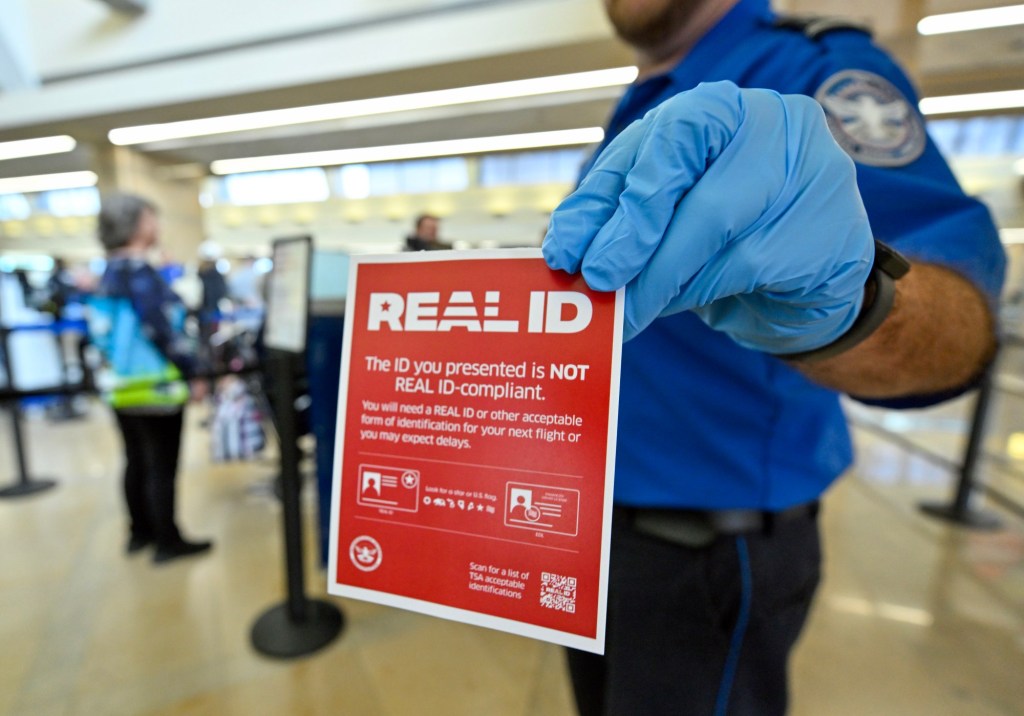The first morning of Real ID didn’t cause chaos at Southern California airports, as the long-delayed security enhancement born in the wake of the 9/11 tragedy took flight for the first time.
A Transportation Security Administration official said that on Wednesday, May 7, the streams of flyers going through checkpoints to get to flights was drifting along real well.
“I’ve been in contact with the team out there all morning since we opened, and it’s been smooth operations — no impact, no wait times,” Jason Pantages, a TSA federal security director, said about Ontario International Airport. “It’s really been like a normal Wednesday at ONT.”
Not only at Ontario, but elsewhere, too, such as at Los Angeles International Airport.
“At LAX, we’ve seen zero operational impact and no excessive wait times,” he added.
At some point, flyers might need a Real ID or another federally accepted ID, such as military one or a passport, to hop aboard flights traveling throughout the United States and to enter some federal buildings.
For now, passengers who don’t have accepted IDs, Pantages said, should get to the airport early.
“You would go through the security checkpoint, go through the queue like everyone else does,” Pantages said. “Once you get up and you’re identified as not having a Real ID-compliant identification, we’ll hand you a piece of paper that says you’re not real ID compliant.
“Then you may or may not be subject to additional screening,” he added. “But we don’t anticipate turning anybody away for not having real ID-compliant identification. … There would be a 100% chance that you will fly today.”
Nationwide, TSA officials said, about 19% of travelers were arriving without a Real ID on Day One. At LAX, Pantages said, that rate was slightly lower.
Federal officials had been fuzzy on what would happen to those without proper ID, even though the U.S. Congress created the need for this added layer of security way back in 2005, and the date it would go into effect had been moved back a couple of times. On Tuesday, though, Secretary of Homeland Security Kristi Noem said slack would be given, that those without the ID “may be diverted to a different line, have an extra step, but people will be allowed to fly.”
At Ontario International Airport on Wednesday morning, there were light crowds and short lines. There was no wait at the TSA checkpoints.
“We came early because we saw on the news it might be crowded, but we actually got through luggage drop-off pretty fast,” said Sandra Cazares, 57, a hotel receptionist. “Now we’re just waiting to go through security. I made sure we got our Real IDs last year to avoid any issues.”
Her husband, Tobias Cazares, 57, added, “I get why they’re doing it, but it feels a little unnecessary to have to get a new ID.”
Sandra Cazares said their flight was on time but noticed travelers seemed more stressed than usual: “You can just tell by the looks on their faces.”
Near the Alaska Airlines counters, Rosa Martinez, 31, was at a self-service kiosk holding a hand of her toddler while printing out boarding passes. “I thought it would be a mess today, but it’s actually been really easy,” she said. “I got my Real ID a few months ago just to be safe, and I’m glad I did because I know a lot of people who waited last minute.
“It’s annoying, of course, to have to get yet another identification to prove I’m me,” Martinez said. “But what can you do? I feel like it’ll also help me feel more safe when flying now with my daughter, to be honest.”
At LAX, signs were posted at TSA and PreCheck lanes informing passengers about Real ID, and agents handed out red cards with QR codes linking to a list of acceptable forms of ID and guidance on how to obtain a Real ID. TSA also had extra agents working overtime to support the rollout.
David Moore, 31, was in the American Airlines terminal getting his boarding pass to get back home to Houston, Texas, where he works as a pediatric emergency-room doctor. He has had a Real ID for a few years.
“I think it’s good,” he said. “It provides an extra layer of security and hopefully, in the long run, that will make things more efficient when it comes to travel. Just like any new implementation of a security procedure, it takes time, but then once it’s kind of put into place, it usually becomes more efficient with time.”
To Moore, Wednesday looked like a normal traveling day.
“I think everything else seems pretty much the same,” he said, “and it doesn’t seem to be affecting too many people.”
Jenny Hudson, 41, from Orlando, Florida was waiting to catch a flight back home. Hudson travels a lot with her job as a registered nurse. She had flown with a patient to LA.
“I got my Real ID two weeks ago,” Hudson said. “It went pretty fast and easy this morning at the airport.”
At John Wayne Airport, Greg Skibo and Sarah Mutt were headed to Pittsburgh with their 4-year-old son, Onyx. The couple had gotten Real IDs years ago.
“I thought it was going to be a huge line this morning, and it was going to be really crowded,” Mutt said. “I was kind of freaking out because we weren’t two hours early — and this isn’t bad at all. So far, everything seems fine.”
Some travelers feel less motivated to get their Real IDs, even if the rules eventually tighten up, including Jennifer Lumsdon who was here for a conference and headed back to Bloomington, Illinois.
“Anytime I can avoid the DMV, I’ll do it,” she said. “I have a passport, and I have my driver’s license — why should I have to go through that all again?”
Originally Published:











